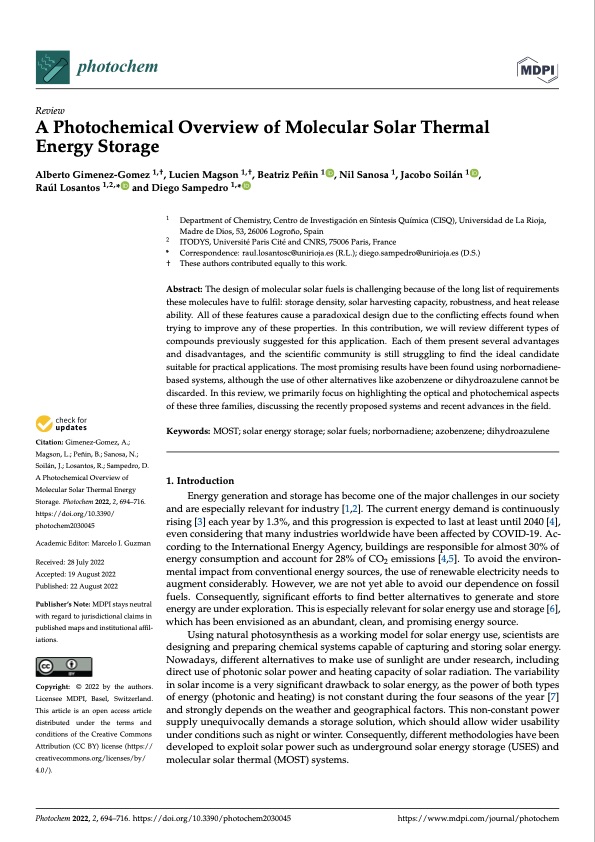
PDF Publication Title:
Text from PDF Page: 001
Review A Photochemical Overview of Molecular Solar Thermal Energy Storage Alberto Gimenez-Gomez 1,†, Lucien Magson 1,†, Beatriz Peñin 1 , Nil Sanosa 1, Jacobo Soilán 1 , Raúl Losantos 1,2,* and Diego Sampedro 1,* 1 2 * Correspondence: raul.losantosc@unirioja.es (R.L.); diego.sampedro@unirioja.es (D.S.) † These authors contributed equally to this work. Abstract: The design of molecular solar fuels is challenging because of the long list of requirements these molecules have to fulfil: storage density, solar harvesting capacity, robustness, and heat release ability. All of these features cause a paradoxical design due to the conflicting effects found when trying to improve any of these properties. In this contribution, we will review different types of compounds previously suggested for this application. Each of them present several advantages and disadvantages, and the scientific community is still struggling to find the ideal candidate suitable for practical applications. The most promising results have been found using norbornadiene- based systems, although the use of other alternatives like azobenzene or dihydroazulene cannot be discarded. In this review, we primarily focus on highlighting the optical and photochemical aspects of these three families, discussing the recently proposed systems and recent advances in the field. Keywords: MOST; solar energy storage; solar fuels; norbornadiene; azobenzene; dihydroazulene 1. Introduction Energy generation and storage has become one of the major challenges in our society and are especially relevant for industry [1,2]. The current energy demand is continuously rising [3] each year by 1.3%, and this progression is expected to last at least until 2040 [4], even considering that many industries worldwide have been affected by COVID-19. Ac- cording to the International Energy Agency, buildings are responsible for almost 30% of energy consumption and account for 28% of CO2 emissions [4,5]. To avoid the environ- mental impact from conventional energy sources, the use of renewable electricity needs to augment considerably. However, we are not yet able to avoid our dependence on fossil fuels. Consequently, significant efforts to find better alternatives to generate and store energy are under exploration. This is especially relevant for solar energy use and storage [6], which has been envisioned as an abundant, clean, and promising energy source. Using natural photosynthesis as a working model for solar energy use, scientists are designing and preparing chemical systems capable of capturing and storing solar energy. Nowadays, different alternatives to make use of sunlight are under research, including direct use of photonic solar power and heating capacity of solar radiation. The variability in solar income is a very significant drawback to solar energy, as the power of both types of energy (photonic and heating) is not constant during the four seasons of the year [7] and strongly depends on the weather and geographical factors. This non-constant power supply unequivocally demands a storage solution, which should allow wider usability under conditions such as night or winter. Consequently, different methodologies have been developed to exploit solar power such as underground solar energy storage (USES) and molecular solar thermal (MOST) systems. Department of Chemistry, Centro de Investigación en Síntesis Química (CISQ), Universidad de La Rioja, Madre de Dios, 53, 26006 Logroño, Spain ITODYS, Université Paris Cité and CNRS, 75006 Paris, France Citation: Gimenez-Gomez, A.; Magson, L.; Peñin, B.; Sanosa, N.; Soilán, J.; Losantos, R.; Sampedro, D. A Photochemical Overview of Molecular Solar Thermal Energy Storage. Photochem 2022, 2, 694–716. https://doi.org/10.3390/ photochem2030045 Academic Editor: Marcelo I. Guzman Received: 28 July 2022 Accepted: 19 August 2022 Published: 22 August 2022 Publisher’s Note: MDPI stays neutral with regard to jurisdictional claims in published maps and institutional affil- iations. Copyright: © 2022 by the authors. Licensee MDPI, Basel, Switzerland. This article is an open access article distributed under the terms and conditions of the Creative Commons Attribution (CC BY) license (https:// creativecommons.org/licenses/by/ 4.0/). Photochem 2022, 2, 694–716. https://doi.org/10.3390/photochem2030045 https://www.mdpi.com/journal/photochemPDF Image | Overview of Molecular Solar Thermal Energy Storage

PDF Search Title:
Overview of Molecular Solar Thermal Energy StorageOriginal File Name Searched:
photochem-02-00045-v2.pdfDIY PDF Search: Google It | Yahoo | Bing
Turbine and System Plans CAD CAM: Special for this month, any plans are $10,000 for complete Cad/Cam blueprints. License is for one build. Try before you buy a production license. More Info
Waste Heat Power Technology: Organic Rankine Cycle uses waste heat to make electricity, shaft horsepower and cooling. More Info
All Turbine and System Products: Infinity Turbine ORD systems, turbine generator sets, build plans and more to use your waste heat from 30C to 100C. More Info
CO2 Phase Change Demonstrator: CO2 goes supercritical at 30 C. This is a experimental platform which you can use to demonstrate phase change with low heat. Includes integration area for small CO2 turbine, static generator, and more. This can also be used for a GTL Gas to Liquids experimental platform. More Info
Introducing the Infinity Turbine Products Infinity Turbine develops and builds systems for making power from waste heat. It also is working on innovative strategies for storing, making, and deploying energy. More Info
Need Strategy? Use our Consulting and analyst services Infinity Turbine LLC is pleased to announce its consulting and analyst services. We have worked in the renewable energy industry as a researcher, developing sales and markets, along with may inventions and innovations. More Info
Made in USA with Global Energy Millennial Web Engine These pages were made with the Global Energy Web PDF Engine using Filemaker (Claris) software.
Sand Battery Sand and Paraffin for TES Thermo Energy Storage More Info
| CONTACT TEL: 608-238-6001 Email: greg@infinityturbine.com | RSS | AMP |